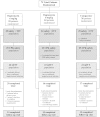Randomized controlled trial of the safety and efficacy of Daptomycin versus standard-of-care therapy for management of patients with osteomyelitis associated with prosthetic devices undergoing two-stage revision arthroplasty
- PMID: 22908174
- PMCID: PMC3486533
- DOI: 10.1128/AAC.00038-12
Randomized controlled trial of the safety and efficacy of Daptomycin versus standard-of-care therapy for management of patients with osteomyelitis associated with prosthetic devices undergoing two-stage revision arthroplasty
Abstract
The prevalence of Staphylococcus aureus causing prosthetic joint infection (PJI) supports investigation of higher doses of daptomycin in the management of PJI. This was a prospective, randomized controlled trial studying safety and efficacy of daptomycin (6 and 8 mg/kg of body weight) compared with standard-of-care therapy for PJI. This open-label study randomized 75 patients undergoing 2-stage revision arthroplasty to daptomycin at 6 or 8 mg/kg or a comparator (vancomycin, teicoplanin, or semisynthetic penicillin). After prosthesis removal, patients received 6 weeks of antibiotic treatment and a 2- to 6-week antibiotic-free period before implantation of a new prosthesis. Test of cure (TOC) was within 1 to 2 weeks after reimplantation. The primary objective was evaluation of creatine phosphokinase (CPK) levels. Secondary objectives were clinical efficacy and microbiological assessments. Of 73 CPK safety population patients, CPK elevation of >500 U/liter occurred in 4 of 25 (16.0%) (daptomycin, 6 mg/kg) and 5 of 23 (21.7%) (daptomycin, 8 mg/kg) daptomycin-treated patients and 2 of 25 (8.0%) comparator patients. Adverse-event rates were similar among daptomycin and comparator groups. Among modified intent-to-treat patients at TOC, clinical success rates were 14 of 24 (58.3%) for 6 mg/kg daptomycin, 14 of 23 (60.9%) for 8 mg/kg daptomycin, and 8 of 21 (38.1%) for the comparator. Overall microbiological success at TOC was 12 of 24 (50.0%) for 6 mg/kg daptomycin, 12 of 23 (52.2%) for 8 mg/kg daptomycin, and 8 of 21 (38.1%) for comparator patients. In conclusion, daptomycin at 6 and 8 mg/kg given for up to 6 weeks was safe and appeared to be effective in managing staphylococcal PJI using a 2-stage revision arthroplasty technique in a total of 49 patients.
Trial registration: ClinicalTrials.gov NCT00428844.
Figures

References
-
- Antony SJ, Angelos E, Stratton CW. 2006. Clinical experience with daptomycin in patients with orthopedic-related infections. Infect. Dis. Clin. Pract. 14:144–149
-
- Antony SJ, Tiscareno-Grajeda I, Misenhiemer G. 2009. Use of daptomycin in the treatment of prosthetic joint infections: a prospective observational study of 30 patients with infected prosthetic joint infections. Internet J. Infect. Dis. 7 doi:10.5580/1479 - DOI
-
- Berbari EF, et al. 1998. Risk factors for prosthetic joint infection: case-control study. Clin. Infect. Dis. 27:1247–1254 - PubMed
Publication types
MeSH terms
Substances
Associated data
LinkOut - more resources
Full Text Sources
Medical

